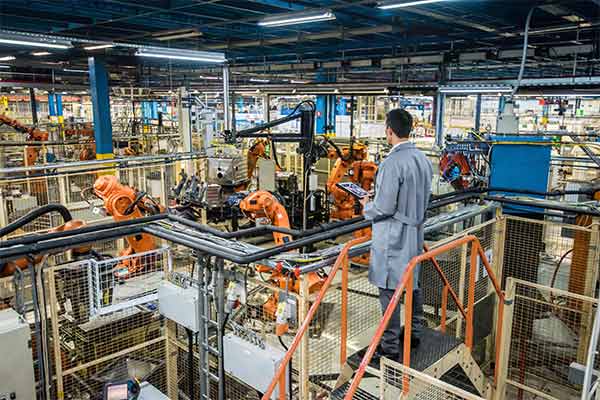In this time of disruption, manufacturers should digitalize workflows to increase resilience and agility.

By: Linda Ding, Laserfiche
In the wake of the pandemic, we’ve seen major labor shortages, driven by widespread personnel retirements.1 Supply chain professionals in particular have left their jobs in droves, as they experienced higher levels of worker burnout during the pandemic. This has further stretched already-thin supply chains built for just-in-time fulfillment. The questions of sudden workforce shortages and supply chain management accentuate changes to how companies now operate. “Work from home for a few months” has now become “work from home forever,” challenging network capacity, security protocols and communications.
Manufacturers are digitalizing their operations to accommodate these disruptions. Even firms that began digital transformations before the pandemic must rethink their approach in light of new developments. The pre-2020 transformations centered on creating efficiencies at scale and meeting customer demand — business as usual. Moving forward, digitalization projects must also solve for labor shortages and supply chain hiccups.
What should today’s transformations look like? Despite connotations of shiny IoT sensors and AI-enabled platforms, industry executives define digital transformation in terms that aren’t quite as flashy. A recent IndustryWeek survey of manufacturing managers and executives asked respondents what digital transformation means to them and their company. They aligned on the following definitions:
Digital transformation in today’s complicated manufacturing environment is all about … creating digital paper trails? That makes sense when you consider just what goes into producing one part. Purchase order, bill of materials, blueprints, to name a few; not to mention a whole host of supply chain-management documentation detailing each piece’s journey to its final destination.
What happens if the person responsible for a supply chain-management document repository retires? How accessible are the vital records to every other branch in a remote-work environment? Can business as usual continue without the appropriate product documentation? It’s no wonder 38% of polled companies find a lack of standardization of documents challenging or extremely challenging to workflow management.
More than one-third of respondents struggle to standardize documentation, and more than 20% list each of inventory management, workforce training, product specs, and material handling systems at the top of their digitization to-do lists. These business processes are all dependent on compliant documentation and audit trail. Efficient document control has been an ongoing struggle for many manufacturers due to the volume of document types and hand-written information, and many have not digitized processes that standardize the document creation and archival.
Digitizing paper trails improves operational transparency so that firms can better anticipate setbacks and prepare strategic plans for future growth. Yet, digital transformation is not something to approach in one fell swoop. Manufacturing leaders can leverage the following recommendations for successful digitalization.
The vast majority (58%) of respondents indicate that “competing priorities” is the biggest obstacle to digitizing workflow processes. Before embarking upon any digitization journey, organizations must align all stakeholders and determine the best course of action. Which processes should be digitized first? How much value will the digitization effort bring to the business? What systems and data do we have in place now that we should continue investing, or should we rip and replace?
It’s likely each stakeholder has a different answer to these questions. Achieving alignment is the only way to break through this initial barrier to digitization.
In other words, silos must go. Respondents were asked to provide their top three most-important features when it comes to compliance document handling. The overwhelming first choice was “a unified directory for all documents across the enterprise.” This response dovetails neatly with respondents’ views of workflow management challenges. Thirty-six percent felt having “multiple sources of information with no centralized/standardized system for processing” was challenging or extremely challenging.
It seems that no matter what the specific task or business area in question, respondents are most concerned about standardization, especially across systems. Wherever organizations turn for their first digitalization project, it’s clear that standardizing processes must be a major component of said initiative.
If standardizing workflow processes is the major goal of breaking down the silos, then how to achieve that standardization across cores systems is the next question to answer. More than one-third (35%) of companies plan to upgrade their enterprise resource planning (ERP) system. And when asked which system they’ll integrate with an automated workflow/document-management system, 41% responded “ERP.” Manufacturing firms are overhauling centralized planning and need their new systems to integrate seamlessly with workflow-management systems.
However, backend integrations are often costly and resource intensive. When working with integration partners on more complex data integration projects, firms can also consider low-code tools such as Robotic Process Automation (RPA) for routine and manual processes, such as data lookups and cross-system data sync-up, which can easily cut down the integration cycle by more than a third.
Manufacturers hope that digital transformations can help them address labor shortages, remote work, and day-to-day inefficiencies. And despite the allure of machine learning and IoT sensors, the biggest pain point for industry leaders is document management. Survey responses indicate a path forward for firms that wish to modernize their workflow processes as a solution to various challenges they face. By aligning priorities, focusing on standardization and ensuring effective integrations, manufacturers can solve the problems of today … and tomorrow.

Linda Ding is the senior director of strategic marketing for Laserfiche. In her role, she focuses on technology trends affecting highly regulated industries, including workflow automation, digital customer service delivery and data analytics. Ding speaks frequently at industry events on a variety of topics surrounding digital transformation including the deployment of automated systems, compliance with regulatory requirements and integration strategies. Ding holds B.A. degrees in Economics and Cognitive Science from the University of California, Berkeley and an M.A. degree in Program Evaluation from Claremont Graduate University. In 2017, she was named among the “Ten to Watch” by wealthmanagement.com and received the “Fintech PR Rising Star” award from PRNews.
1 https://bfi.uchicago.edu/insight/finding/labor-force-participation-plummets-but-us-experiences-modest-rise-in-unemployment/
In this episode, I sat down with Beejan Giga, Director | Partner and Caleb Emerson, Senior Results Manager at Carpedia International. We discussed the insights behind their recent Industry Today article, “Thinking Three Moves Ahead” and together we explored how manufacturers can plan more strategically, align with their suppliers, and build the operational discipline needed to support intentional, sustainable growth. It was a conversation packed with practical perspectives on navigating a fast-changing industry landscape.